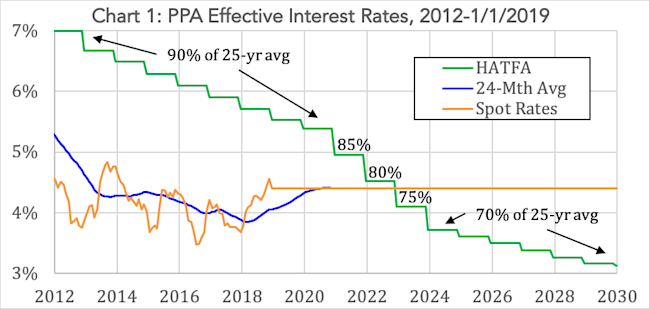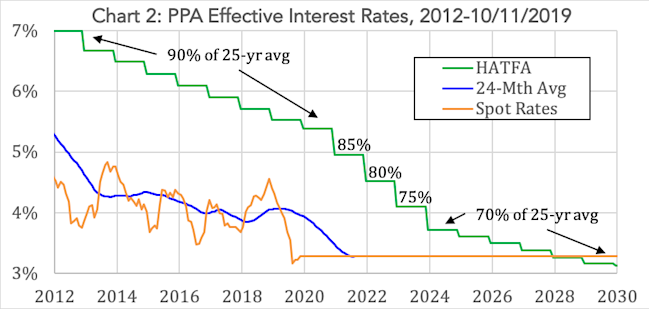Interest rates 2019 – DB funding strategy
In this article, we begin with a review of the interest rates used for plan funding – 25-year average Highway and Transportation Funding Act (HATFA), 24-month average, and one-month spot rates – reflecting the significant declines this year. We then consider the short- and medium-term effect of those declines on sponsor funding requirements. We conclude with a brief review of the effect of those declines on the calculation of PBGC premiums, financial disclosure, and “real life.”
Interest rates as of October 2019
The two charts below provide a picture of what funding looked like at the beginning of the year and how it has changed through mid-October 2019.
Chart 1 compares historical and projected (1) 25-year average HATFA, (2) 24-month average, and (3) spot rates for a typical pension plan, reflecting changes in market interest rates through the beginning of 2019, with spot rates projected forward at 1/1/2019 levels.
Chart 2 does the same thing, only it carries interest rates forward to 10/11/2019 and then projects rates forward at those levels.


Minimum funding – HATFA until 2028
How has the minimum funding outlook changed since the beginning of the year? As of 1/1, assuming no further change in interest rates, we were projecting that market interest rates would be higher than HATFA rates by 2023, stabilizing (for our “typical plan”) at about 4.4%.
Since the beginning of the year, rates have gone down more than 100 basis points. At this level, HATFA rates will continue to apply until 2028. For sponsors concerned about ERISA minimum funding demands, that is bad news. Here are the minimum funding basics if this new environment persists:
Until (on our projections) 2028, HATFA rates will be the rates used to value liabilities for ERISA minimum funding purposes. Those rates currently equal 90% of a trailing 25-year average of rates.
During the period 2019-2020, HATFA rates will go down marginally as more “low interest rate” years are added to the 25-year average.
During the period 2021-2024, HATFA rates will then (per the statute) be reduced to 85% of the 25-year average (in 2021), 80% (in 2022), 75% (in 2023), and finally 70% (in 2024).
After 2024, and (on our projections) until 2028, our typical plan’s effective discount rate will be 70% of the HATFA 25-year average – around 3.7% in 2024, declining to 3.1% by 2030.
After 2028, market rates would exceed 70% of the HATFA 25-year average, stabilizing at around 3.3%, and would thereafter apply for ERISA minimum funding purposes.
Thus, the changes resulting from the huge 2019 decline in interest rates will not be felt for ERISA minimum funding purposes until 2023 – the year in which, prior to the decline, we were predicting that market rates would exceed HATFA rates. If rates remain at current levels, for the period from 2023 on, sponsors will have to fund based on liabilities calculated using much lower discount rates than we had projected at the beginning of the year.
This will matter both for what we have called “funding regime one” – the base rules for the minimum a sponsor must contribute – and for “funding regime two” – the set of limitations on design and administration that are triggered when plan funding falls below 80%/60%.
We want to emphasize that our projections here are simple and are most useful as an illustration of the consequences of 2019 interest rate declines. We are assuming that future interest rates will be the same as present rates. If, as some expect, interest rates go back up, the minimum funding picture will improve. If, as others expect, they go down further, it will get worse.
PBGC premiums – interest rate declines will increase 2020 PBGC variable-rate premiums
As noted above, the recent decline in interest rates will not affect ERISA minimum funding until 2023 (at the earliest and depending on each plan’s own funding situation). In this context, the primary statutory driver of funding decisions for many sponsors is likely to be PBGC variable-rate premiums.
The 2020 variable-rate premium (generally) equals 4.5% of a plan’s unfunded vested benefits (UVBs), measured based on either year-end 2019 spot rates or 24-month average rates. In either case, for 2020, (unless rates move up significantly before year-end and assuming, e.g., no additional contributions) a plan’s UVBs and its variable-rate premium will be higher – in many cases significantly higher.
We review the technicalities of the measurement of UVBs in detail in our article Interest rates 2019 – measuring UVBs for variable-rate premiums. And we discuss strategies for reducing variable-rate premiums that sponsors may wish consider in our recent article Interest rates 2019 – managing funding and PBGC variable-rate premiums in a volatile interest rate environment.
Financial disclosure – interest rate declines will increase liabilities and expense
We’re not going to review the effect of interest rate declines on financial disclosure in detail. We simply observe that declines in market interest rates, if they persist through year-end, will show up on year-end 2019 balance sheets (liabilities for a typical plan could increase 20% this year, although assets have done pretty well this year too). Barring accelerated recognition, however, the near-term impact on the income statement will, as always, be muted.
Real life – contributions vs. investment returns
After working through (1) what the statute makes sponsors do and (2) what FASB makes issuers do, it is generally useful to consider (3) what in real life the sponsor will have to do. In that regard (and staying brief) we note:
In the long run (and unless the sponsor liquidates in bankruptcy), the sponsor will have to contribute enough to its DB plan to pay all benefits and overhead costs. That cost will be affected (positively or negatively) by net returns on the plan’s asset portfolio. Speaking very broadly, declines in interest rates are associated with increases in the value of assets on the books and declines in future returns.
Latitude in funding – e.g., HATFA relief – allows the sponsor to delay making plan contributions with the prospect of earning its way (via asset returns) to improved funding.
Funding relief carries with it, however, a tax, assessed at more or less current market interest rates, on underfunding – the PBGC variable-rate premium.
In this context, sponsors will want to consider (among other things) the following variables in making funding decisions: (1) their overall cash strategy, (2) the cost of PBGC variable-rate premiums, (3) the long-run cost of the plan, (4) any financial disclosure statement risks/concerns they may have, and (5) their plan investment strategy.
Finally, we note that a further extension of HATFA relief, in 2019 or 2020, is a possibility.
* * *
We will continue to follow this issue.
